Chapter Five—
Outsiders and Cheap Lodging Houses
The great reformer jacob riis understood cheap lodging houses. He had lived in them as a young immigrant in New York. He had smelled and listened to conditions in 25-cent hotels, 10-cent flophouses, and free police station lodgings. In How the Other Half Lives , his famous slum exposé of 1890, the only kind of hotels that Riis mentioned were cheap lodging houses. As he put it, "There is a wider gap between the 'hotel'—they are all hotels—that charges a quarter and the one that furnishes a bed for a dime than between the bridal suite and the everyday hall bedroom of the ordinary hostelry."[1] Riis's photographs explain why, when reformers wrote the words "cheap lodging house," readers could almost see the authors curling their upper lip in disgust (fig. 5.1). To say "cheap lodging house" was to say "dirty tramp."
Most lodging house denizens were not dirty tramps but unskilled day laborers whose work included digging ditches and carrying materials to extend and to finish the turn-of-the-century city. In the backgrounds of Riis's photographs were remnants of the old city: wooden shacks, leftover piles of dirt and gravel, stretches of weeds, and vacant lots. Much of the American city in 1890 was not only old and dilapidated; much was also raw and unfinished. Riis and his fellow reformers hoped
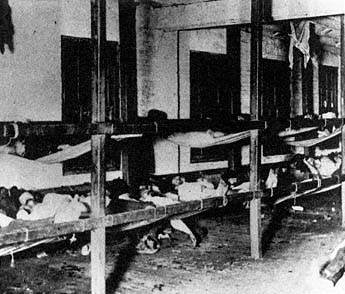
Figure 5.1
A hammock-style cheap lodging house. A Jacob Riis
photograph of Happy Jack's Canvas Palace on Pell Street
in New York City, 1890s.
to keep slums of all kinds, including cheap lodging houses, from the permanent and proper parts of the city then under construction.
Both low wages and their own subculture kept casual laborers in cheap lodging houses and out of better hotels or other housing. In better neighborhoods, rooming house residents were merely down on the socioeconomic ladder; however, the low-income men and women who lived in cheap lodging houses were both down and out . They were unwelcome in most of the city but nonetheless essential for the volatile urban and rural economy. The owners and managers of cheap lodging houses not only responded to the hierarchies of the casual laborer subculture but also negotiated an uneasy three-sided truce among unskilled single workers, the captains of industry and agriculture who employed them, and the urban residents who saw the workers—at best—as a necessary evil.
Essential Outcasts
To outside observers, the gangs of hired laborers at construction sites or in farm fields seemed to be members of a single category: tramp. However, casual workers themselves pointed out vital differences within their caste, often using a three-line rule of thumb:
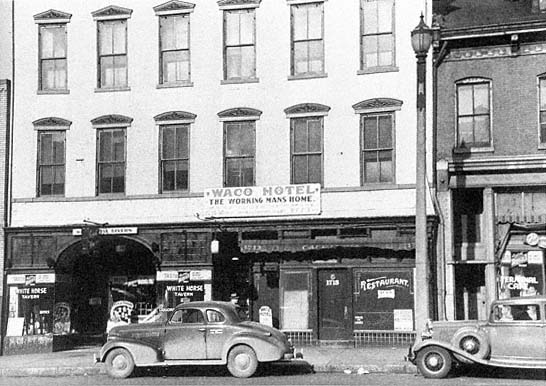
Figure 5.2
The Waco Hotel, St. Louis. When photographed in 1939, rooms were 25¢, 35¢, and 50¢ a day.
Note the tavern and restaurant on its ground floor.
A hobo works and wanders.
A tramp dreams and wanders.
A bum drinks and wanders.[2]
All three groups of men appeared unattached to a family; they had few possessions, enjoyed recreational drinking, worked intermittently, and traveled often. People in the categories of tramp and bum did the most to give casual laborers a bad reputation, yet they made up only a small share of the whole group, for instance, only 2,500 out of Chicago's 100,000 casual workers. Tramps and bums were migrant non workers, often dirty and slovenly. Hoboes were workers who often shared or aspired to many middle-income values.[3] Together, hoboes, tramps, and bums represented a hotel group that writers—historically as well as today—have erroneously called "homeless men." The casual laborers who lived in cheap lodging houses were no more homeless than the mining kings or opera divas who lived in palace hotels (fig. 5.2). Hotels were also an integral part of the casual labor supply and its culture.
Nels Anderson, a hobo who later went on to become a University of Chicago sociologist, defined the true hobo as the "in-between worker, willing to go anywhere to take a job and equally willing to move on later." In rural and remote wilderness locations, hoboes dug ditches, carted bricks, and tended animals in the construction of mines, railways, highways, and oil fields. In farm regions, hoboes followed the harvests of grain, corn, fruit, potatoes, beets, cotton, or hops. During the winter, smaller numbers of men did lumbering or cut ice. According to Anderson, most boys or men moved out of the hobo work force within ten years of entering it.[4] In city locations, gangs of casual workers toiled over the menial tasks involved with building industrial plants and street railroads, paving streets, laying pipe and wire for gas and electric systems, and erecting new buildings. Casual laborers were also former carnival workers, part-time sailors, and extra hands for industrial and shipping peaks at docks, warehouses, and factories (fig. 5.3).[5] In the 1920 census, San Francisco registered over 17,000 general laborers and another 7,000 people working as longshoremen and sailors (table 4, Appendix).
In the economy of the nineteenth century and early twentieth century, demand for hobo labor fluctuated wildly, even in comparison with the unstable work conditions for skilled workers. A bumper crop, a new railroad company, sudden demands for lumber, or an oil boom instantly employed thousands of new people and created the need to house them. Just as instantly, business downturns wiped out those positions. A slowdown in 1908 meant that American railroads employed 236,000 fewer men than they had employed the year before. When work was plentiful, hoboes came to the city to sign up at employment agencies catering to casual laborers; the agencies then sent them back out to distant labor sites. Some California farm workers migrated to and from the same San Francisco hotel for over fifty years.
Due to the fluctuation of casual laborers' work, summer occupancies in cheap lodging houses could drop to 40 percent of capacity. When rural work for casual laborers declined sharply in the winter months, large numbers of hobo laborers returned to the city. By late November, urban lodging houses were at full occupancy and beyond. Lodging house keepers doubled up people in rooms and set more cots out into the hallways. The residents lived as long as possible on their summer earnings and picked up odd jobs, but winter urban work was also
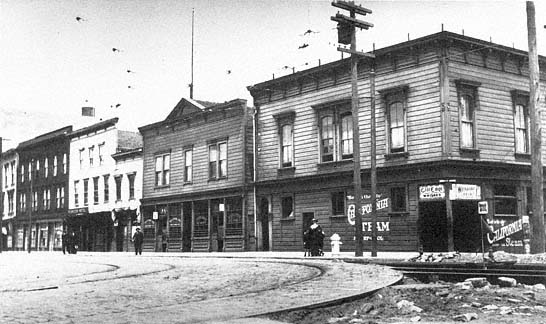
Figure 5.3
Sailors' boardinghouses photographed in 1913, Steuart Street, San Francisco. These waterfront structures
had survived the fire of 1906 and could thus remind San Franciscans of Victorian hotel slums.
scarce. During January, February, and March, industrial employers in San Francisco cut their work forces by an average of one-fourth (a cut of 12,000 jobs in 1921).[6] Cheap lodging houses were also permanent residences for stationary casual laborers or the "home guard," men spending some stationary years before resuming hobo life or formerly migrant men too old or unwilling to go back on the road.
Urban casual laborers were paid by the day and lived by the day. Often resisting the tedium of a steady job, they worked from a day to a week at jobs. Their indoor work included stints as porters, janitors, waiters, dishwashers, or potato peelers. In "King of the Road," Roger Miller summarized the immediate work-hotel relationship: in 1964, "two hours of pushing broom" bought an "eight by twelve four-bit room."[7]
Photographs and reports from the turn of the century show that workers' hotel districts were not full of elderly, hard-drinking men, as the 1950s stereotypes of those districts suggest. Riis declared in 1890 that he found a high proportion of able-bodied men in New York's Bowery—"young men, unsettled in life, . . . fresh from good homes, beyond a doubt with honest hopes of getting a start in the city and making a way for themselves" (fig. 5.4).[8] At the turn of the century, at least one casual laborer out of eight might be under twenty years of
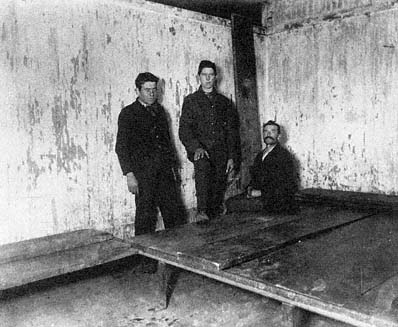
Figure 5.4
Police station lodgers, including two young men. In the 1890s,
Jacob Riis photographed the bare comforts of this police station
lodging room in New York City, where he had slept in 1870.
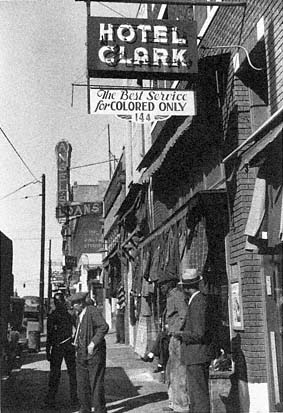
Figure 5.5
Racial segregation in cheap lodging houses.
A hotel on Beale Street in Memphis, Tennessee, 1939.
age, and most were in their middle years. After World War II, the elderly proportion increased; in Sacramento in 1953, men over fifty-five comprised about one-third of the lodging house population.[9]
In some regions of the United States, new immigrants and racial minorities made up significant parts of the casual labor markets. In 1880, a fourth of San Francisco's hired laborers were single Chinese men no longer sent out to do far-flung railroad and field work. They comprised almost 90 percent of the 3,000 employees in the cigar and tobacco industry and over half the labor force in the boot and shoe manufactories. A dual labor agency system prevailed in San Francisco through the 1920s; Japanese and Chinese workers were hired from "Oriental" employment agencies.[10] In other cities, blacks were the more significant racial minority in the single laborer population, and blacks had the most trouble finding housing. In 1925, a black carpenter complained to authorities that he was unable to secure a lodging house room in San Francisco; all the cheapest hotels had drawn the "color line" (fig. 5.5).[11]
Before World War II, in spite of the notable presence of minority casual laborers, in large cities most casual laborers were white and American-born. They were usually in-migrants from the countryside, where mechanization had made them superfluous. Almost all had permanently separated from their families. In fact, these were distinctly non family, nonhousehold people. The few who had wives or children were rarely in contact with them and had cut off most other typical family ties as well.[12]
When a lifelong single laborer became feeble or too old for hard physical work, he survived with odd jobs and rough domestic work such as raking leaves or shoveling cinders. As such work gave out, as it did during the 1930s when younger men competed for marginal jobs, the older men went on starvation economy programs, moved to the cheapest lodging houses, lived on as little as 25 cents a day, and then pawned what they could of their possessions (including overcoats and eyeglasses) to pay their hotel bills, trusting to odd jobs for their food. As a last resort, single laborers applied for work or aid at a mission, a Salvation Army wood yard, or a soup kitchen. After age sixty-five, all but the strongest were forced to go to an almshouse or hospital for at least part of the year.[13]
Although lodging houses were overwhelmingly a male workers' realm, women lived there as well. In 1890, a San Francisco reporter
asked the keeper of a 10-cent lodging house what he did when women applied for a room. "If they've got the money [15 or 20 cents] we try and put them in a room by themselves," answered the desk clerk. When the reporter asked what happened if they did not have the money, the clerk replied, "Well, if they've only got ten cents, or the other rooms are full, they have to take their chances with the rest."[14] Women were as many as one out of ten migrant workers during the depression; national estimates then ranged from 14,000 to 50,000 women on the road. In New York City's Bowery district, perhaps the nation's most famous lodging house zone, out of the sixty-three cheapest hotels, three were for women and four for boys. In most cities, commercial and social services for women were not nearly as well developed as those for men. Bertha Thompson, better known as Box-Car Bertha, wrote about using women's informal information networks to find urban housing, often shared with other women.[15] Nonetheless, cheap lodging house districts had the most skewed gender distribution of all types of residential hotel areas, as shown in a series of age and sex pyramids drawn for Chicago in 1920 (fig. 5.6).[16] Even in the cheap lodging house pyramid, with its dramatic curve for men, women make up a clearly discernible proportion, many of them living in small dilapidated rooming houses that had sunk to lodging house prices and standards.
Urban lodging houses also served as repair stations for work place casualties. In the decades when few employers paid for incapacitating injuries at work and when few workers had a labor union or insurance, handicapping accidents or job-caused diseases sent thousands of single workers each year to permanent hotel life in the city. Casual laborers knew the county hospitals, dispensaries, and medical colleges in large cities. In 1911, according to Alice Solenberger's study of one thousand men in Chicago's cheap lodging houses, one-fourth were either temporarily crippled or permanently maimed.[17]
The most desperate lodging house denizens were those whose incomes made housing hard to find and who in addition had the bad luck, marginal psychiatric state, or personal weaknesses to keep them out of all housing except commercial hotels, police stations, or public institutions. These outcasts often became permanently unemployed and castigated as "industrially inefficient." Solenberger deduced that 9 percent of the dependent tramps and bums—the people who dreamed and drank more than they worked—did so because they were mentally ill.
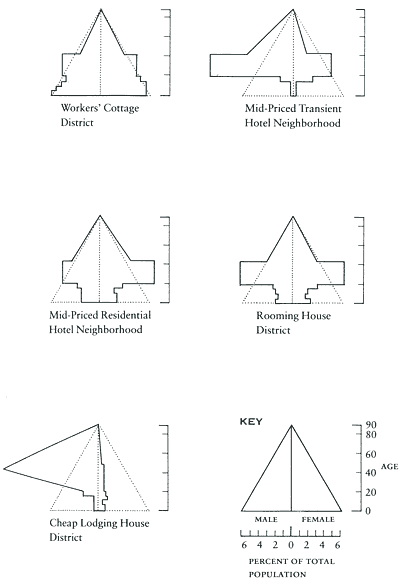
Figure 5.6
Age-sex pyramids for Chicago hotel neighborhoods in 1920.
Dotted lines indicate the national average, with young people at
the base, elderly at the top. Males are on the left of each pyramid,
females on the right. Men particularly predominate in cheap lodging
houses; women are prominent in rooming houses and midpriced areas.
Heavy drinking also led to underemployment of hotel residents, although only a tenth of the drinkers in lodging houses may have been true alcoholics. Reports of cocaine, heroin, or morphine addiction also came from the cheap lodging houses more often than from the more polite hotel ranks.[18]
Low-caste professional crooks found both shelter and a continual supply of hapless victims in cheap hotels. When migrant workers got to town, the tricksters and prostitutes were ready for them. Robbing men while they were drunk or asleep became something of a specialty near lodging houses. Narcotics sellers, bootleggers, and pickpockets could also be found in hotel areas of all sorts.[19] Outside observers assumed everyone was a criminal in San Francisco's Barbary Coast, the zone of rooming houses, boardinghouses, saloons, and manufacturing buildings located between Chinatown and the piers. In cheap San Francisco hotels in the nineteenth century, the verb "to shanghai" replaced "to crimp" for the process of drugging or knocking out sailors and then sending them out to sea as unwilling crews on ships (while the lodging house master pocketed the saved-up pay the sailor had just given him). Reporters said conditions in other ports were similar or worse.[20] On the subject of criminals living in lodging houses, Riis and other reformers loved to quote New York's Police Superintendent Thomas Byrnes, the most famous detective of his era. In the 1880s, Byrnes had traced 27 percent of the city's police book arrests to men who lived in the cheap hotel district. The lodging houses, he said, were "nurseries of crime."[21]
In spite of the dire pronouncements of people like Byrnes and early sociologists, single casual laborers did not lead socially disorganized lives. The historian Robert Slayton has shown how casual laborers thoroughly knew their place within an elaborate social hierarchy. To match the general outline of the workers' social structure and income variations, hotel owners offered a hierarchy of cheap lodging houses.
No-Family Houses
Hoboes, home guard workers, tramps, and bums constituted a tough group of customers. However, hotel owners and managers rose to the challenge, spurred on by the potential for reliable profits. As Slayton
has argued, the value and cash price of different types of lodging houses were based on the degree of privacy and autonomy they offered their residents. The higher the price, the greater the privacy.[22] The lower the price, the more one lived in a group. From top to bottom, however, cheap lodging houses were home to people largely living outside the family and without access to the rest of the city; lodging houses were the ultimate "no-family house."[23]
Architecturally, cheap rooming houses shared features with their richer rooming house cousins. Typically, neither rooming houses nor lodging houses had dining or restaurant facilities. Only when they were very large or in old midpriced hotel buildings did they have any lobby or reading room on the ground floor. Their neighborhood locations sometimes overlapped. Nonetheless, prospective tenants quickly learned to distinguish an inexpensive rooming house from a cheap lodging house. The respectable rooming house operator always charged by the week or the month; the cheap lodging house keeper charged by the day and only occasionally offered weekly rates. To reach the stairs of a smaller lodging house of the nineteenth century, tenants often had to walk through a saloon where the bartender doubled as the desk clerk. In other buildings, the doors between street and stairs often gave clear architectural signals—the better rank of dwelling usually having side windows and more of a setback from the sidewalk.[24] Interior features, however, were most important. Once one left the doors and the stairs, lodging houses showed themselves to be very different from rooming houses.
Rooms, Cubicles, Wards, and Flops
Price normally separated lodging house amenities into three very distinct levels: (1) full private rooms for 25 to 40 cents a night; (2) semiprivate cubicles or open wards for 15 to 25 cents a night; and finally, (3) flophouses that charged from 5 to 10 cents a night for a dry space on an open floor (fig. 5.7).[25] All these prices are for the 1920s.
For 40 cents, the tired laborer in a private-room lodging house had a room, 10 feet by 10 feet or smaller in dimension. In 1913, a San Francisco health inspector gave this telegraphic description of a small 40-cents-a-night lodging house used by both men and women:
Folsom Street rooming house. Three-story frame. Saloon on first floor. Thirty-nine rooms [upstairs]. Skylight in hall does not ventilate. Five inside rooms on
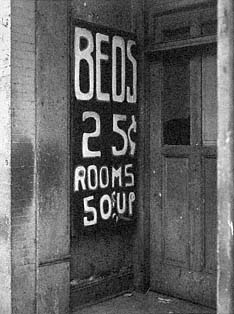
Figure 5.7
Cheap lodging house rates.
The entrance to a skid row hotel on West
Main Street in Norfolk, Virginia, in 1941.
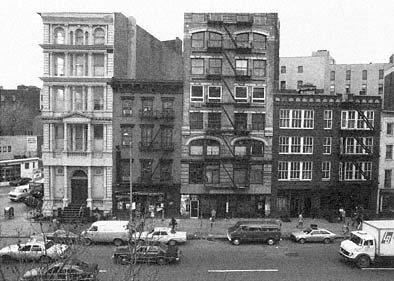
Figure 5.8
Hotels on the Bowery in New York City, photographed in 1986.
These tall lodging houses and other structures remain
from the years before World War I.
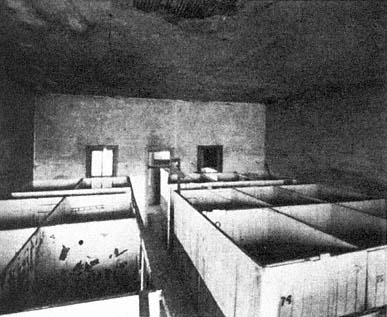
Figure 5.9
Cubicles in a high-ceilinged loft space, photographed before 1923.
The partitions are about 7 feet tall.
each floor have window in unventilated hall. One fire escape; one stairway; large hall; four toilets; four baths; twelve stationary basins. Hot water in bath rooms. . . . Many rooms have double beds.[26]
As the inspector's figures show, each floor had a men's and women's bathroom, for a ratio of one bath to every ten rooms. In most cheap lodging houses, the one to five rooming house ratio fell to one to ten or one to twenty—a ratio hovering at or below the legal minimums.[27] For the entire building, in Chicago or New York, five or more stories were common (fig. 5.8). In smaller cities, three or four stories were the rule.
Inside the 40-cent lodging house, the minimum list of room furnishings might be only a dilapidated bed (sometimes with a straw mattress), one rickety chair, and a hook for clothes. At the very best, conditions might match those of the largest cheap lodging house in San Francisco, the Central Hotel, where the 440 rooms were tiny, but most had a small dresser and a basin with hot and cold running water.[28]
For only 25 cents (again, in 1920s prices), the tired and nearly broke renter could stay in either a cubicle- or a ward-style lodging house. The patrons called the cubicles "cages" or "cribs": they were stalls made of wood or corrugated iron partitions about seven feet high. These partial walls offered visual privacy inside large loft spaces whose ceilings were ten to fourteen feet high (fig. 5.9). Having several hundred cubicles in
one building was not unusual. The cubicles measured as little as five by seven feet for a single bed or seven by seven feet with two cots or a double bed. The remaining area inside a cubicle left room for a chair and space for the occupant to pull off his or her clothes.
In cubicle hotels, the manager's provision of a chair was not always assured but very handy. Veteran lodgers folded their clothes and placed them under the chair to prevent their being hooked with fishing tackle from over the partition. Cubicles earned their "cage" nickname from the chicken wire that managers stretched over the open tops of stalls to prevent thefts and to keep people from sleeping in the spaces without paying. After the installation of electricity, each cubicle might have its own 15-watt bulb; before then, gaslights overhead lit the whole space.[29]
The cubicle room's great significance—having a private space to lock and a room for coming and going as one pleased—was the most important boundary in the range of privacy and independence offered by cheap lodging houses.[30] At the next lower level were the open dormitory wards, areas crowded with rough homemade bunk beds or cots. In such a dormitory area, each guest had at the most a locker for clothes. If one did not have a locker, one World War II resident remembered, "one major problem was what to do with your wallet when you took a shower."[31] In some dormitory wards, tenants could gain access to the room only after dark; at 6:00 A.M. the sleepers would all be roused and moved out. Seasonal peaks at urban industrial sites or months of high unemployment packed the dormitory areas with residents. Edith Abbott gives this graphic description of a ward-type lodging house in a good working-class suburb near Chicago in the 1920s:
The beds were not clean, and very often were occupied by relays of men, the day shift and the night shift, the bedding scarcely becoming cold after one occupant had left it. . . . This is known as the "hot bed." . . . The beds were usually left unmade, a higher rental being charged if the boarding-housekeeper attended to their making.[32]
Most cheap lodging houses offered a mixture of rooms, cubicles, and wards to compensate for fluctuations in occupancy. A Folsom Street hotel in San Francisco offered 10-cent beds in a dormitory behind the first-floor saloon, 15-cent cubicles in the interior of the loft spaces above, and a few 25-cent cubicles that had windows on the street or alley. Of the 101 licensed cheap lodging houses in New York City in

Figure 5.10
Typical floor plan with cubicles, ca. 1900. Reconstructed from a rough 1980s diagram of the
Kenton Hotel on the Bowery in New York City. Varied cubicle sizes and angled passageways
were common.
1905, 36 were of the full-room or cubicle type, 34 were of the open ward type, and the remaining 31 had both wards and cubicles. It was typical to put wards on the remote upper floors of tall buildings and cubicles on the second or third floor (fig. 5.10). Thousands of people in most large cities lived whole seasons and from year to year in cubicle and ward hotels.[33] Cubicle lodging houses had a direct building-type equivalent in crib or cage bordellos, some of them with hundreds of tiny cubicles, some fit with window shades that rolled up when patrons put in coins. Other bordellos and cheap lodging houses had canvas walls instead of matched lumber partitions.[34]
If a cubicle hotel offered heat (not all of them did), it came from over-worked and red-hot stoves often strategically blocking the narrow passages between cubicles. In some lodging houses, the only conditions worse than the heating supply were the vermin, general filth, and horrific smells, all resulting from the conditions of the tenants themselves, bad hotel maintenance, and poor ventilation. Lice, other bedbugs, and mice were constant problems. A San Francisco reporter wrote that "the persistent scratching of the sleepers proclaimed that their beds had other tenants that were not asleep."[35] During cold weather, people in the front or rear cubicles closed their windows, thus sealing the ventilation for the whole floor. In hot weather, the few windows (open or not) were completely inadequate. In short, year-round there was virtually no ventilation at all. In some corners, odors of urine or foul clothing overwhelmed tenants and visiting inspectors alike. Spittoons were everywhere, and one observer wrote that "it is the general custom in

Figure 5.11
Three types of cheap lodging houses.
All were built in San Francisco from 1906 to
1909. Top left , a 39-room hotel annex in a loft
structure with no specialized light wells;
top right , a 35-room hotel on the two upper
floors with below-code light wells; bottom ,
the Central Hotel, with 440 tiny rooms and
minimal light wells satisfying early codes.
lodging houses to require those who spit profusely to spread a newspaper on the floor beside their beds."[36] In some cubicle hotels, as few as two toilets served 180 occupants. Bathtubs or showers may have been absent altogether. Residents might find one common drinking cup per floor and common towels that one critic compared to "those in a fourth-class printing office." Managers kept staff to a minimum; therefore, the beds, walls, and floors stayed unclean.[37]
Not surprisingly, disease conditions, social concerns, and fire dangers brought cheap lodging houses repeatedly to the attention of city officials. In 1917, the state of California outlawed construction of new cubicle hotels. Since that time, code enforcement and downtown development have gradually eliminated all cubicle rooms in San Francisco, although their use continued in the city through the 1950s. In Chicago, a 1963 sample of lodging house residents found that 75 percent of the 10,690 respondents still lived in cubicle hotels. Nine percent lived in
missions, and only 16 percent lived in private room hotels. In a 1986 estimate, New York City still had 3,500 people living permanently in cubicles and dormitory beds, some of the buildings dating from the 1890s.[38]
Most cubicle lodging houses were in temporary buildings or general-use lofts erected with light industrial or warehouse uses in mind (fig. 5.11). The Bonanza House was a 55-foot by 100-foot loft building that stood next to several similar buildings on San Francisco's Market Street in 1885. In the basement were a saloon and a bakery oven; an eating establishment occupied the first floor. The second and third floors were lodgings, probably of the cubicle sort, and a shoe factory occupied the top floor.[39] Not all cubicle hotels were such large structures. In 1906, the builders of Thomas Turish's lodging house in San Francisco's South of Market district fit sixteen rooms into what today would look like a long two-car garage—a one-story wood frame structure on a back alley lot with no apparent source of heat.[40]
Not even cubicle conditions matched the lowest lodging house variant, the flophouse. Ten-cent flophouses often occupied two or three floors of a loft building—one similar to those used for cubicle hotels but usually in poorer condition. Flops had no permanent installations whatsoever, rarely even beds. Some had mattresses or piles of rags with a blanket available. Others had long rows of canvas hammocks. Others simply offered customers a dry place on the floor where they could unroll their newspapers or bedrolls. Flophouse owners offered no lockers; there was little need of them since the tenants typically owned very little. Most flops did not open until winter, when migrant workers surged into the cities. They were temporary operations and moved from year to year, yet even flophouses with simple canvas slings could turn a profit. Riis knew one otherwise respectable and wealthy New Yorker who operated three such establishments and made $8,000 a year clear profit.[41]
Still lower on the commercial scale were informal private lodging houses—unlicensed dives where a lodger could sleep in a corner of a tenement room for 5 cents, or for 3 cents curl up in a sheltered hallway and not be moved out until morning. By the 1920s, the owners of all-night movie theaters had added to the urban landscape a variant of the flophouse. Local law in some cities (including San Francisco) closed movie theaters at night. Local law in other cities, such as Los Angeles,
allowed people to sleep all night for 5 cents in an uncomfortable wooden seat in a room that was at least dark and dry, if not well ventilated.[42]
While conditions in urban lodging houses could be bad, they were often better than those offered at distant road excavations, mines, or lumber camps. The nineteenth-century U.S. Army set the hoped-for standards for the peacetime industrial army; real conditions could be much worse. At one lumber camp in 1916, inspectors found tents with men crammed into triple makeshift bunks with only straw for mattresses. At Baltimore's suburban Sparrows Point steel plant in the 1890s, two thousand laborers (mostly recent immigrants and blacks) rented space in the plant's barracks—long rows of one-room shanties, 10 feet by 14 feet, built of rough pine boards and roofed with tar paper. Each room housed four men, who provided their own mattresses, stove, and fuel; only after 1904 were a shower house and cookhouse available. Low rent and direct proximity to work were the advantages; at $2 to $3 per month per man, only charity lodging houses could have beaten the price.[43]
Subsidized Missions
The urban provisions for day laborers and the elderly poor alarmed politicians, philanthropists, and social activists. They waged sporadic campaigns to offer subsidized alternatives to the cubicle and flophouse hotels, just as institutional alternatives were provided for the other hotel ranks. Some attempts were minimal. In the 1890s in Chicago, for instance, the city opened up the floors of the City Hall; on winter nights as many as two thousand people slept there. More commonly, police rounded up (or took in) street denizens in downtown police stations overnight. There, the tenants found stern, clean, and usually unpadded benches or plank platforms for beds (fig. 5.12). Police lodgings served a relatively small group. In 1889 in New York City, only 400 people—half of them women—slept in the police lodgings each night, while an average of 13,000 New Yorkers slept in commercial lodging houses.[44]
Progressive Era reformers lobbied strongly for better public facilities. New York opened America's first municipal lodging house (other than police lodgings) in 1896. By 1902, seven other large American cities had such buildings, and up to World War I the numbers grew. At these, indigents could sleep a few nights on an iron cot and receive two meals
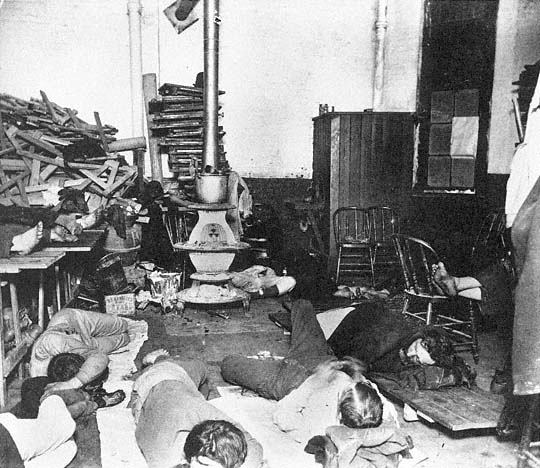
Figure 5.12
The men's lodging room in a New York City police station typifies overcrowding in a makeshift
institutional flophouse. To both sides, note the feet of men sleeping on platforms and chairs.
a day—at least rolls and coffee—if they agreed to put up with interrogation, fumigation, a shower, a promise of docile behavior, and often at least two hours a day chopping wood or cleaning alleys. During periods of high employment, the number of lodgers dropped sharply. During World War I, most cities closed their lodging houses for lack of use; cities reopened their shelters as the rural economy worsened in the 1920s and rapidly augmented them during the depression. By the 1920s in progressive states, counties augmented urban shelters with county relief homes or work farms.[45]
A few philanthropists also subsidized the construction of landmark workers' hotels. The benefactors relinquished the usual 15 percent or more made on urban real estate investments but expected a safe 6 or 7 percent return nonetheless. The most famous East Coast example, the 1897 Mills Hotel built by Darius O. Mills, covered an entire block

Figure 5.13
Exterior view of the Mills Hotel No. 1, built in 1897
as a subsidized lodging house on Bleeker Street in
New York City.
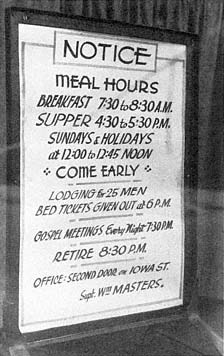
Figure 5.14
Schedules and regulations posted in a
mission window in Dubuque, Iowa, 1940.
front in Greenwich Village and visually dominated the neighborhood. By the 1960s, its social situation had devolved to such an extent that it became the first hotel in New York to be called a "welfare hotel," but that was hardly Mills's intention (fig. 5.13). Its designer, the well-known reform architect Ernest Flagg, included 1,500 well-ventilated cubicle rooms, each five by seven feet.[46] On the West Coast, the palace of workingmen's lodgings was San Diego's Golden West Hotel, a three-story concrete structure of 450 private rooms designed in 1913. While the Mills Hotel is now remodeled as a chic condominium, the Golden West is still a workingmen's hotel. Urban philanthropy standards were also matched at the better company towns built in the United States after 1900.[47]
In 1891, the Salvation Army opened its first U.S. operations in New York; ten years later, they had forty-four missions in the country; by the 1920s, their numerous buildings and enthusiastic marching bands automatically invoked images of a fundamentalist struggle to save souls and to offer free or nearly free beds and food. The Salvation Army was one part of a wide range of missions and shelters that various benevolent groups began to sponsor after the Civil War. Some were simply
basement or upper-floor flophouses, and their sanitary problems rivaled the worst commercial conditions. The field notes about one shelter in St. Paul tersely said, "Charitable Institution. . . . Old Opera House made over; Fire Marshall condemned it."[48]
The supervision in institutional lodging houses was, of course, as notoriously strict as that in municipal lodging houses (fig. 5.14). Institutional lodgings were generally cleaner than cheap commercial lodgings, and they also offered meals, either free (in return for a sermon or prayer meeting) or at very cheap rates. A work shift at San Francisco's Salvation Army wood yard, for instance, entitled men to a bed ticket and a 20-cent meal ticket that could be split into a 5-cent and a 15-cent meal. At the wood yard (a vacant lot) men cut and stacked cords of wood for sale to the public. Some missions also gave out tickets redeemable for meals or lodging at nearby commercial establishments. In a few large northern cities, separate "Negro Corps" were formed; southern Salvation Army services for blacks were segregated until the Supreme Court's decision on segregation in 1954.[49]
For single hoboes, housing options other than cheap lodging houses or missions were slim. Their chance of securing a polite apartment was no more likely than attaining a berth on a luxury ocean liner. Groups of single laborers occasionally ganged together to rent a tenement space and to hire a cook. The places they could get were in the worst tenements or back rooms and cost $1.50 each per week in 1910. In the mid-1920s, a clean-living casual laborer might (with a persistent search) secure a windowless hall bedroom in a low-end rooming house for $2 to $3 a week, probably around the corner from a cheap lodging house. For comparison, a cubicle room or flophouse cost $2 or less a week.[50]
Zones for Single Laborers:
Skid Row and Chinatown
By the 1950s, most Americans had learned to use the pejorative term skid row for large areas of cheap lodging houses and their surroundings. But before the 1950s, these areas—with their high concentration of hotel housing—were very different places, for which the term single laborers' zone might be more appropriate. Even if polite citizens had rarely been to a skid row area, the names of those areas evoked vivid images. People often knew the area by the name of its major street: in
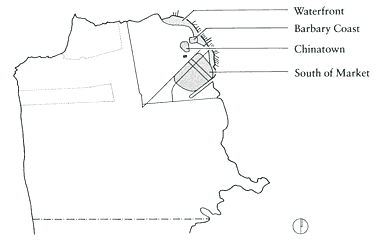
Figure 5.15
Single workers' neighborhoods in San Francisco. The small black
rectangle is Union Square. Streets indicated in the South
of Market are Third, Fourth, and Howard.
New York, the Bowery; in Minneapolis, Upper Hennepin Avenue; in Baltimore, Pratt Street; in Boston, Scollay Square; in Chicago, the Main Stem on West Madison Street; in Los Angeles, South Main Street.[51] Large cities typically had more than one single laborers' zone, and San Francisco had three: Third and Howard streets in the South of Market, the waterfront and Barbary Coast area, and Chinatown (fig. 5.15). Common characteristics of the people inhabiting these districts were unskilled and low-paid work, living outside of a private household of any sort, and being ostracized from the rest of the city. Differentiating the fates of the various districts were the survival of the jobs, the nature of activities mixed into the district, the degree of social ostracization, and competition for the land itself.
The Migrant Workers' South of Market
San Francisco's huge district south of Market Street had several neighborhoods within it, most of them packed with immigrant families living in tiny cottages and threeroom flats. Before World War II, the area was overwhelmingly white. In 1960, the population of the district was still over 75 percent white, with 14 percent black and 9 percent Asian. The South of Market flour mills, sawmills, refineries, printing plants, and machine shops generated large numbers of jobs for skilled workers and unskilled casual laborers.
Outsiders knew Third Street and Howard Street as the South of Market; these streets were the core of the casual workers' South of Market (fig. 5.16). Migrants often arrived in the railroad freight yards and walked north along Third Street. By the time they reached the corner
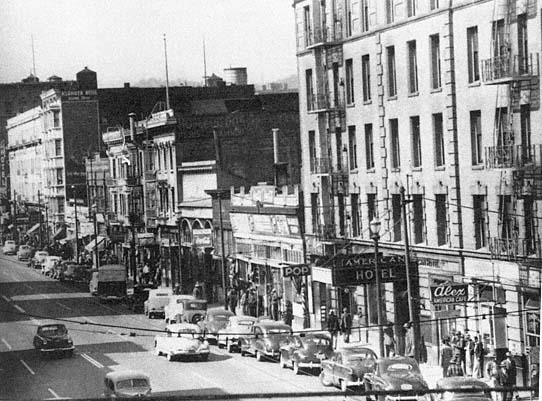
Figure 5.16
Third Street in San Francisco, 1953. Above the first floor virtually every building is a workers' hotel built
before 1920. Today, this is approximately the location of the Moscone Convention Center.
of Third and Howard they would have found all that they needed to be at home for the day, week, or month. A 1914 survey estimated that 40,000 single men lived in the South of Market at the peak of the winter, and half of the city's cheap lodging house rooms were in the district.[52] About a third of these men were permanent city residents.
By the turn of the century, Third and Howard streets were a typical single and migrant laborers' zone, a place that mixed cheap work, cheap rooms, cheap liquor, and cheap clothes. At its heart were multiple employment agencies in rented storefronts. Seven major employment offices competed next to each other on Howard Street between Third and Fourth, a very long block that is the site of the present-day Moscone Convention Center; other, similar agencies were located in the surrounding blocks.[53] Early in the day and in times of high employment, the agency clerks filled their shop windows and the interior walls with chalked placards listing jobs. At the beckoning of "800 HANDS TO COLUSA—SOUTHERN PACIFIC RR" or "40 SHOVELERS—4TH STREET," the men would be off to work for the day or the month. Outside the
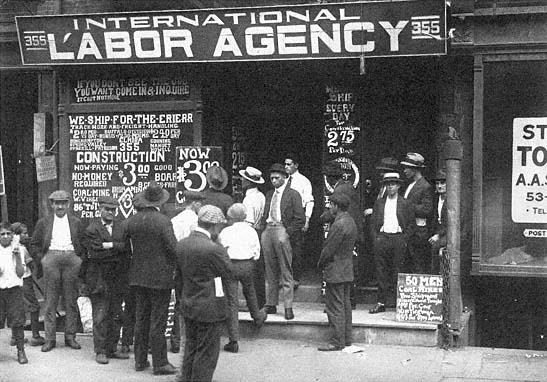
Figure 5.17
A labor agency on New York City's Lower West Side, 1910.
labor agencies men would stand and wait to register for work or for other listings to appear (fig. 5.17). In 1907, Nels Anderson and a friend stood on Omaha's great hobo employment center, Douglas Street, and estimated that they could see a thousand men on the streets and sidewalks. In slack times, the sidewalks outside the labor agencies were still the prime outdoor loitering and meeting spots of the workers' zone. People often loitered on the sidewalks throughout the year in such districts because there was no place to sit other than in a bar, card room, or other commercial establishment.[54]
Other prominent elements of the South of Market were working-men's saloons. Along Third, men found the greatest concentrations of workers' saloons, many with back room "bookie joints" that were legal until 1938. By 1910, San Francisco's saloons no longer served a free lunch, but they offered hearty 10-to 15-cent meals with the purchase of a glass of beer. Nearby were a distinctly grubby class of pool rooms and penny arcades. An occasional amusement hall, concert saloon with its cheerful and gladdening bathing beauties, and later, cheap movie theaters all added to the mix along the ground floors. Upstairs through
much of the zone would be the cheap rooms, cubicles, and dormitory spaces of the lodging houses.
Single laborers' zones also offered essential retail services for the workingman. San Francisco's South of Market had fifty-one second-hand clothing stores, twenty-one of them on the employment-office block of Howard Street alone. Retailers offering new clothing did not do so for "gents," as in the rooming house districts, but called themselves "outfitters": they sold serviceable boots, Levis, heavy shirts, and gloves for distant work camps. Trunk shops and storage locker businesses catered to men leaving town for a season. Radical bookstores supplied reading material aimed at a workers' revolution. A third of the city's pawn shops were also in the district, not far from charity missions and the Salvation Army "institute" or wood yard, which was on a side street. There were barber colleges offering free haircuts, medical and dental schools offering low-cost clinics. Men could also get dental work done on credit in the single workers' zone. In San Francisco, Greek migration was strong after 1910, and the local colony of Greeks began to run South of Market tea- and coffeehouses and inexpensive restaurants frequented by single men. In the evenings, some of the shops offered exotic dance shows. Houses of prostitution or assignation were never far away, but the single workers' zone in any city had fewer women and children visible on its streets than any other residential or commercial district of the city.
Bargain eating shops filled the interstices of the South of Market. Near cheap lodging houses workers always found the most reasonably priced food. A few large lodging houses had inexpensive eateries in them and offered American plan rates to their residents. Most lodging house tenants at the turn of the century, however, relied on saloon fare and the cheapest 5-cent to 15-cent lunchrooms available. For breakfast, San Francisco's Bolz Coffee Parlor promised "three of the largest doughnuts ever fried and the biggest cup of coffee in the world" for 10 cents. Coffee Dan's advertised "one thousand beans with bread, butter, and coffee" for 15 cents.[55] On a crash economy program, a man or a woman could eat three meager meals a day for as little as 30 cents in the mid-1920s. One elderly man gave this minimum-price daily menu:
Breakfast: "coffee and," 5 cents; sometimes with mush, 5 cents extra
Noon: hash, soup, bread, and coffee, 10 cents
Supper: stew, bread, and coffee, 15 cents[56]
At such rates, neither food nor service enticed the diners' palates. Over-worked waiters got plastered with food; stale bread and sour milk were common.[57] The cheapest meals were mission provisions given out free (fig. 5.18).
Life in the South of Market and other American migrant workers' areas began to change in the 1920s because of shifts in the demand for cheap work. As owners mechanized their factory, farm, mine, road-building, and lumber operations, they dramatically cut the need for casual migrant workers. The remaining migrants began to drive rickety automobiles to their work; in Kansas in 1926, for instance, over half the harvest workers came to the wheat fields by car. Having gradually lost the business of robust migrant workers who arrived by train, districts like the South of Market began to be identified more with the home guard.[58]
San Francisco had two other well-known single workers' areas. The Barbary Coast, although much tamed after its rebuilding from the 1906 fire, was still considered a disorderly district. It housed a great number of San Francisco's single sailors and longshoremen.[59] Inexpensive rooming houses and cheap lodging houses dominated the housing supply, mixed with various wholesalers' lofts, bawdy saloons, and houses of prostitution. San Francisco was the base for thousands of military men, and in their off-duty hours they often gravitated to the Barbary Coast (to the chagrin of their officers). After World War II, with the rapid decline of work for San Francisco's break-bulk water-front, the port workers were no longer needed; the recreational culture of the area was seen as an increasing threat. Not surprisingly, the Barbary Coast and waterfront areas were early targets of official and private redevelopment beginning in the 1950s. In the adjacent Chinatown, however, the neighborhood in 1990 stood much as it was rebuilt after the 1906 fire, and had similar uses.
Racial Rooming House Districts:
The Chinatown Example
The racial ghettos of many cities have had a high number of inexpensive hotel homes. San Francisco's Chinatown was somewhat unique, since the Chinese were imported as inexpensive laborers early in the city's history and were allowed, even after the fire, to remain in their downtown location—a three-block by seven-block Chinatown crammed with
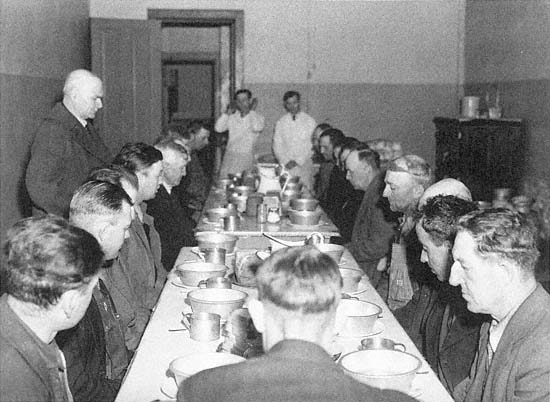
Figure 5.18
Compulsory prayer before dinner at a charitable mission, Dubuque, Iowa, 1940.
boardinghouses and lodging houses. In some ways, Chinatown was much like the Anglo South of Market. Chinatown had many privately owned cheap lodging houses and some better rooming houses; in 1980, half of the area's housing units were still in SROs. Chinatown's streets and basements were filled with affordable retail services and employment offices. There were counterparts to the missions, although Christian missions in Chinatown more vigorously took on acculturation as well as salvation. The population was largely male—but for a different reason. Until the 1960s, federal law forbade importation of wives and created a bachelor society in Chinatown. Wage conditions for the Chinese were even worse than those faced by American-born casual workers. Because of ghetto confinement, the Chinese neighborhood could not expand in spite of population pressures. Hence, the hotel housing conditions were worse. Whites, especially city officials and the police, saw Chinatown as a convenient place to dump (or not see) unsavory characters and illicit activities, even though this meant that gambling
houses, brothels, and drug dens were mixed with a law-abiding population of workers. As in other racial ghettos, a few local residents profited from the dumping process.[60]
Chinatown hotel buildings built after the 1906 earthquake, on their exterior, looked just like their counterparts in the South of Market or waterfront areas. The rooms and windows were similar sizes, often matching code minimums. Inside, however, the forces of economics, management, and ownership forced densities four times those assumed in the building standards. The Chinatown lodging house rooms were crowded with bunk beds. Men commonly slept in shifts, and tenants often did their own cooking in simple communal kitchens. To help each other ignore this appalling population density, Anglos used cultural stereotypes such as "the Chinese tolerate crowding better than white people." Whites (not aware that Chinese were rarely allowed to own property) also defended the densities by pointing to Chinese-managed family association buildings, which had similar densities on their living floors. The multiuse family association buildings functioned in part as subsidized lodging houses. On the ground floor would be commercial spaces leased to leading association members; on the second and third floors were crowded hotel rooms that housed bachelor members; on the top floor were offices, meeting rooms, or social halls for the entire association.[61]
San Francisco's Chinatown was neither monolithic nor completely Chinese. Almost immediately it became an important tourist zone and (on a square-footage basis) probably did far more profitable retail business than did the Howard Street businesses. White workers and non-Chinese Asians also lived in significant numbers on the edges of Chinatown. In the late 1800s, Mexican workers lived directly to the east. After 1900, Manilatown—a concentration of thirty-seven hotels housing up to 10,000 Filipino workers—straddled the border between the core of Chinatown and the Barbary Coast. The workers used the Lucky M Pool Hall as their informal information center. San Francisco's International Hotel, of 1977 eviction fame, was a workers' hotel of a fairly typical 184-room size built in 1907 (fig. 5.19). Twelve stores filled the ground floor, and billiard halls and a well-known nightclub were housed in its basement.[62] A block to the west, in 1939, the permanent residents of the border-location Clayton Hotel revealed the
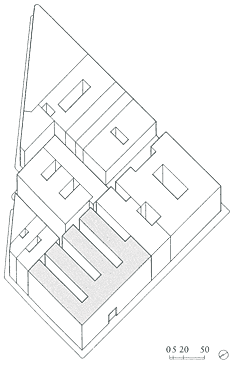
Figure 5.19
Axonometric view of the International Hotel
and surrounding buildings in Manilatown,
San Francisco. The 184-room hotel (shaded)
was built in 1907 with more generous light
wells and larger rooms than average.
In this block, most structures are hotels.
area's ethnic and racial mixture: 25 Filipino, 15 Chinese, and 22 white workers.
While most Chinese were segregated into Chinatowns, city authorities on the West Coast allowed Japanese immigrants to operate and live in rooming and lodging houses in several districts of the city, usually outside of Chinatown. Some white workers preferred Japanese-leased hotels because of their management style. In San Francisco's Western Addition, Japanese-managed hotels seem to have been racially mixed; in the South of Market, all-Japanese residents were more the rule.[63]
Until the 1930s, San Francisco had a very small black population. However, in other cities lodging house districts for blacks were similar to San Francisco's Chinatown. Like Chinatowns, black lodging house districts crowded workers (who were paid less than their white counterparts), suffered from double housing standards in city inspection and code enforcement, and endured a high proportion of unsavory uses dumped there by outsiders. The several-block area of cheap lodging houses in the middle of Chicago's Black Belt was a prime example. It served thousands of black workers who were hired by the railroads and meat packers, where blacks could get jobs earlier than they could in
most other industries (fig. 5.20). In 1990, it remained as one of the largest remaining SRO concentrations on the city's South Side.[64]
Another lodging house pattern, front-gate lodgings, served workers stranded at an eccentric industrial location. For large factories initially built beyond the edge of the city, speculators often built nearby clusters of rooming and lodging houses as well as family houses and flats. San Francisco's Union Iron Works, for instance, employed up to 5,000 men but was four miles from Third and Howard. The hour walk each way to and from the factory cut too much into the casual laborer's day. By 1900—with the factory owners actively encouraging the development—the workers could choose from over thirty commercial wooden rooming and lodging houses and almost as many saloons within three blocks of the factory gate (fig. 5.21).[65]
Rationales for Lodging House Life
For the men and women who lived in cheap lodging houses, the looming advantage was low price. But cheap lodging houses had other advantages. For the indigent elderly, the advantage of ambulatory independence in a central location was particularly prominent. (This was true of other ranks of hotel life as well.) As long as older tenants could walk, they could meet their own needs. California researchers found that elderly residents cherished their independence. Anderson described areas of a few blocks that satisfied all the employment and services needed by former hoboes. A great many of the aged men and women who lived their last years in cheap lodgings lived in grim surroundings. Yet the psychological benefits of maintaining their personal choice and self-reliance seemed to be the most important attractions of staying in hotel housing, just as it is for the elderly in hotel housing today.[66] For workers, cheap hotels and their staff also provided specific stabilizing services. Before 1925, in the heyday of the cheap lodging house districts, men could turn over their summer earnings to the hotel proprietor, who acted as banker and bursar. This ensured that the hobo or sailor would not lose all his money in one first spree.[67]
For the most outcast people—drifters, unemployables, thieves, or prostitutes—rooming houses simply offered a place to be. Technically, state laws required hotel managers to accept any reasonable person for one night, although managers did not have to accept everyone on a weekly or monthly basis. On occasion, however, landlords welcomed
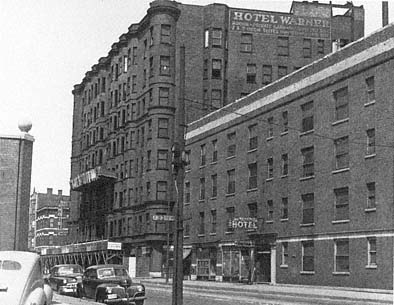
Figure 5.20
Hotels for black workers on Chicago's South Side. The Hotel Warner
and Memorial Hotel on Cottage Grove Street, photographed in 1950.
long-term tenants who were outcasts elsewhere. Poor casual laborers made up a reliable market for slumlords and honest landlords alike. By renting to hoboes, building owners with a warm heart or a dilapidated and unrentable loft space could invest very little money and yet reap a tidy profit. A madam could pay substantially higher leases than other tenants and pay additional sums under the table to the building owner, to district politicians, or to the police. The flophouse floor, even with its vermin, was still a viable commercial space.
The financial pressures on managers who leased cheap hotels probably did the most to open places for outcast people. Each month the lease had to be paid. Only rented rooms brought income. When rooms were going empty, or where the architectural or sanitary conditions were already at a low ebb, undesirable tenants were better than no tenants at all. Managers of "no-tell hotels" that allowed men to take women to their rooms found that they could charge a higher rent. Harvery Zorbaugh asked one hotel keeper how many married couples there were in her house. Her answer: "I don't know—I don't ask. I want to rent my rooms."[68] As long as couples paid, she did not oversee their moral life as old-fashioned boardinghouse keepers might have done. Such management realities, taken to their extreme, fostered the worst social and physical conditions of all types of inexpensive hotels.
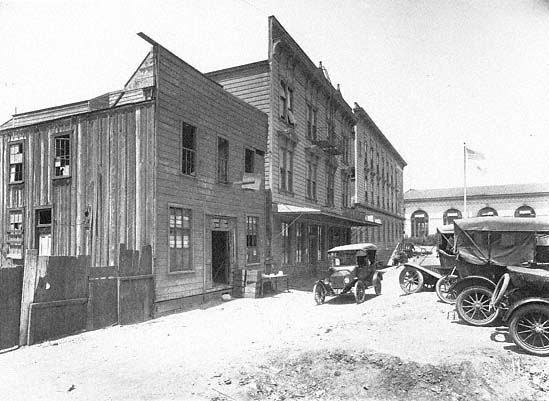
Figure 5.21
Line of wooden rooming houses near the Union Iron Works shipyards in San Francisco, photographed
just before demolition in 1918. The closest building was probably intended to be temporary.
For so-called homeless men, cheap hotels and the area around them were also more than shelter. They were a significant part of hobo identity, just as suburban houses became important for family identity in the middle and upper class. However, unlike suburban houses or better hotels, cheap lodgings were more important as a type of building than as individual structures. The way casual laborers relied on built space contrasted with the manner of the middle and upper class. Wealthy hotel dwellers lived in highly individualistic buildings; their hotel homes were part of an elaborate and individuated material culture system. Midpriced or palace hotel residents could further anchor their identities with their professions, marriage partners, personal pedigrees, and clothes or other possessions. Single laborers, who moved often and easily from one cheap lodging house to another, relied on a more generalized use of the city fabric. They lived largely within a nonmaterialistic and verbal subculture. The social organization and membership in the American day laborer's subculture relied less on unique possessions and more on story telling and social drinking. While less individu-
ally anchored to specific buildings, casual laborers were nonetheless identified with hotels as a group. The anthropologist James Spradley has maintained that flops (places to sleep) made up the most significant set of words in hobo language and culture; no other American group had so many words for places to sleep.[69] Other recent research suggests that, among no-family people, setting in large part can become life-style. The hotels, street corners, parks, and businesses of cheap lodging house districts—even though fluidly used and seen as virtually interchangeable—provided an essential and meaningful backdrop for the single laborers' individual and social worlds. Cheap lodging house districts socially countered the low esteem of hobo employment and provided an island in a hostile dominant society.[70]
Employers and bankers could see advantages to lodging house life, too. The individual freedom of people living completely apart from a family and without material possessions dovetailed precisely with the needs of employers for maximum flexibility and control over a set of workers. The single, more atomized residents of cheap hotels could adjust more easily than family-tied workers to the whimsy of economic demand for a risky new business or a sudden big contract.[71] At a more abstract level of capital circulation, commercial single-room housing had additional benefits for landowners and managers of the middle and upper class. When thousands of workers lived as part of a family or boarded with a family, that rent money went into the family sector; it went back into the control of the private urban community. Hotel life, however, channeled the workers' rent and food money directly into commercial circuits, retail hands, without passing through a private household. More than in family tenement districts, the money of hotel life went into commercial entertainment and commercial socializing. The architecture of the no-family house also displayed these uneasy truces between the renters, the owners, and the employers of the city.
Fronts for Embarrassing Economic Realities
The contrast between the core of downtown and any one of the single laborers' districts rarely failed to jar streetcar and automobile travelers. An equally sharp boundary existed between the facades and interiors of the cheapest hotels. Before 1900, the architectural exteriors of lodging houses usually matched interior conditions. The exteriors of the
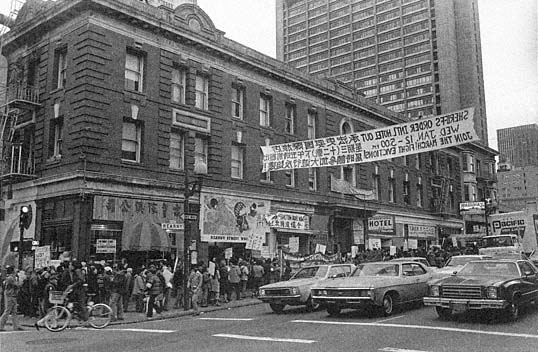
Figure 5.22
San Francisco's International Hotel, photographed in 1977 as demonstrators fought to stop its demolition.
The handsome design of the 1907 facade contrasts strongly with its spare lodging house interiors.
run-down, cheaply constructed wooden lodging houses of the nineteenth century stood out like sore thumbs. They were sore thumbs: social embarrassments, cultural concerns, and architectural eyesores. However, between 1900 and 1920, with no single great inducement, thousands of landowners in American cities were building more polite facades for their lodging houses, exterior images that matched the new commercial world of downtown. The new structures of course reflected production peaks, especially those of World War I. Yet there seemed to be new cultural rules for these buildings.
Keeping in step with national trends, landowners in San Francisco built remarkably schizophrenic lodging houses. The facades and interiors were disassociated; the exterior design and building materials said little or nothing about the uses of the upper floors or the people who lived inside them (fig. 5.22).[72] The interiors of lodging houses were the most reliable material clues to the social and economic standing of their initial residents. The extreme plumbing ratios, minimum air wells, lack of furniture, and narrow hallways made residents immediately and constantly aware not only of their income but also of their place in society (fig. 5.23). Especially for white and American-born workers, the interiors of cheap lodging houses reinforced their cultural alien-
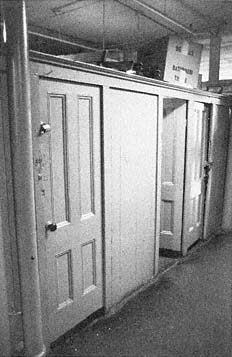
Figure 5.23
Surviving cubicles in a Bowery Hotel.
When photographed in 1986, the area
was being used for storage.
Note articles resting on the wire
ceilings of the cubicles.
ation from the rest of urban society.[73] As capital investors saw it, the interiors of cheap lodging houses were embarrassing necessities for agricultural and industrial production and for commercial and transportation service. In contrast to the interior conditions, the architectural exteriors could easily have been mistaken for lofts or small office buildings of the period.
Admittedly, institutional forces nudged the owners along in their decisions to build in this way. New building codes and their efficient enforcement brought grudging interior changes.[74] But beyond specifying brick construction to stop fires and enforcing various height and bulk limitations to guide building density, neither city nor state bureaucracies had stipulated that owners of purpose-built lodging houses commission the construction of nice facades. Indeed, "nice" is the word for the lodging house facades built after 1900: they were dressed up, made more presentable than their forebears (fig. 5.24). The phenomenon was notable in both rooming houses and lodging houses but more remarkable in the cheaper hotels.
The presentable yet schizophrenic facades built after 1900 were one strategy used by landlords to erase embarrassing images of the social and economic marginality in their properties, and to erect reassuring
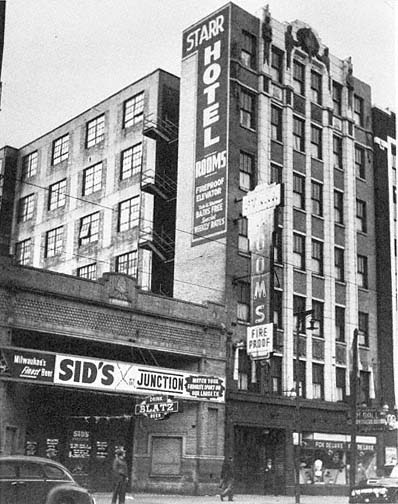
Figure 5.24
A dressed-up lodging house facade in Chicago, contrasting with a more
literal side view. Photographed in 1954.
images of greater cultural uniformity. Of course, landowning citizens also built polite exteriors for individual and personal reasons: for future flexibility and better resale values, for personal pride, or for the desire to be more high-minded business people. The new lodging house facades offered the potential for casual workers' neighborhoods to appear to be respectable, minimally threatening, and permanent. Choosing to give cheap hotels facades that were commercial and not residential was an attempt at making them culturally acceptable both to their residents and to outsiders. The public could imagine that the people inside the new buildings were perhaps not so drastically different a subculture as first-floor sidewalk scenes suggested. For outsiders, at least, the respectability of nice facades visually linked the workers' low-
priced hotel subcultures to the high-priced environments of the dominant culture. The resident hoboes could appear to share with business people the bridge of commercial culture. For the hoboes themselves, the exterior architectural images might also have helped them to feel more a part of the great commercial core of the metropolis.
For their part, the architects of cheap lodging houses (or, more probably, the skilled drafters working for small contracting firms) also exerted their professional and personal desires for a more elegant city, even though their powers for individually influencing buildings of this class were extremely limited. These structures were economically destined to be generic buildings. In reality, the designers' most essential contributions rested in making the floor plans work while getting the most rentable space out of a cramped downtown site.
The schizophrenic relationship of the lodging house facades and their interiors declared that these sorry material conditions were probably the best that the urban political economy of that era could do—reasonably dress up the front and nominally clean up the interiors. It is significant that the owners dressed up the fronts by their own initiative, while the slower improvement of interior standards required a vigilant network of professional reformers and a succession of political battles.
The quality of life and the eventual life spans of cheap lodging houses were thus linked not only to the employment of their residential customers but also to the work of reformers and a specific generation of owners—the people who, after the turn of the century, built hotel life more permanently than it had ever been before. These improvements notwithstanding, in the eyes of politicians, the public, and professional reformers, neither the interiors nor the facades of any lodging houses would ever be adequate. The critics did not want lodging houses and their residents to merge with the city but to vanish entirely. In fact, a coalition of critics intended to prove that no one should live in hotels of any kind—palace, midpriced, rooming house, or lodging house. Given their interests in the hotel business, the hotel property owners naturally stood to disagree. The wide range of the hotel industry itself would prove to work against their common interests.